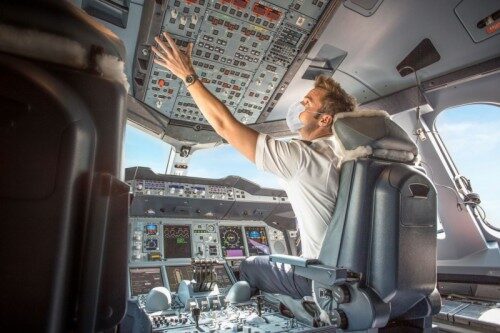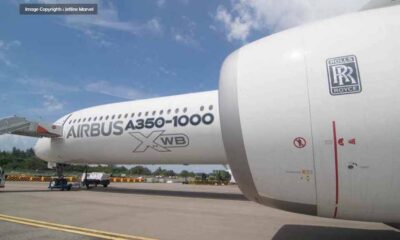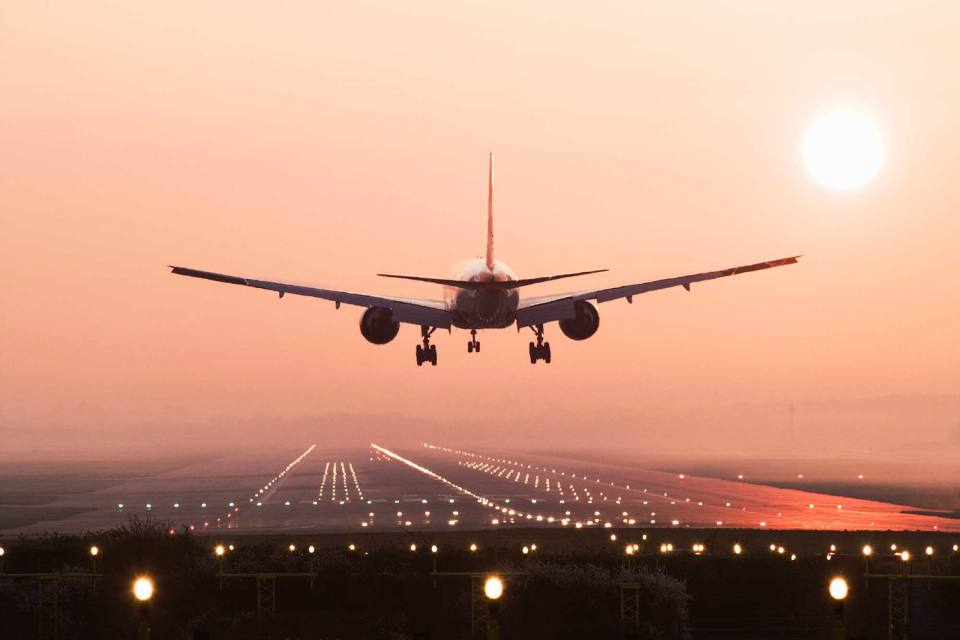Aerospace
Why there may soon be only one pilot on aeroplanes
Airlines will soon have a single pilot in the cockpit.!

Airlines and regulators predict that one pilot will take the place of two in the cockpit of passenger jets. Although it would lower costs and ease pressure from crew shortages, some individuals find it unsettling to give one person such authority.
More than 40 countries, including Germany, the UK, and New Zealand, have approached the United Nations organization that sets aviation rules to request aid in bringing single-pilot aircraft into the mainstream. The European Union Aviation Safety Agency has been creating standards for solo flights in addition to working with aircraft makers to comprehend how they would operate. EASA estimates that such services could start in 2027.
In the early 1950s, the majority of aircraft that operated longer flights used to have a crew of four, consisting of two pilots, one navigator, and an additional flight engineer. This crew’s responsibilities were crucial for the safety of the flight. However, as technology advanced, it began to quickly replace the duties of the additional crew members on the aircraft. The load on the pilots decreased as the aircraft’s instrumentation gradually improved improvements.
Since they fly in connection with the ground and satellites and with the coordination of all flight plans, airplanes are currently becoming more advanced. This makes it possible for aircraft to fly safely and be tracked. As oil costs rise, things will get worse. The effects of the impending pilot shortage would be lessened by single-pilot operations. The amount of air travel keeps growing tremendously. According to a 2018 assessment by the International Civil Aviation Organization and consulting, the world will need to train 5,50,000 more pilots by the year 2037. Around 2025, Oliver Wyman predicts a shortage of 35,000 workers or nearly 10% of the entire workforce.
Why are airlines pushing for a single pilot?
The pilot’s unions are one important issue that has a significant impact on airlines, along with the challenge of educating and retaining more pilots, as well as the remuneration of pilots, which is another important consideration for airlines.
Airlines continuously update their pilots’ knowledge of the safe operation and routine tasks. As long as the expense of automation and the new upkeep of ground operators does not end up costing more, single pilot operations will result in cost savings for airlines. The size and amenities of the cockpit will be reduced to some extent. According to the analysis, the decision to use one pilot rather than two represents a significant cost-saving advance. According to the Swiss financial organization UBS, cutting the number of pilots from two to one would allow airlines it studied to save $15 billion, and a completely automated jet would yield an additional $20 billion.
Southwest pilots union backs Boeing on MAX 7, 10 certification extension(Opens in a new browser tab)
In order to prevent pilot tiredness, some airlines are required to conduct long-haul flights with a third pilot who can switch to the cockpit controls as necessary. Cathay Pacific asked Airbus to develop a technology that can eliminate the need for a third pilot on lengthy flights. Airbus is developing an autonomous system for the A350-1000 aircraft to reduce the need for a pilot in the cockpit. In 2018, it exhibited the capacity to pilot an aircraft with both flying and auto Descent from the cockpit capabilities.
What do pilots think of the concept of a single pilot?
Obviously, the pilot union is opposed to the idea of having only one pilot in the cockpit. They made several reasonable points regarding the advantages of having two pilots in the cockpit for airlines.
Airlines that transport 100 passengers rely solely on their pilots, who are also responsible for ensuring that all safety-related procedures are followed. They cannot be saved from the extreme conditions of aircraft operations by any other means. To operate a plane, two pilots are required.
According to ALPA, airline pilots must be able to maintain control of an aircraft in a constantly changing and dynamic environment. We regularly carry out the required tasks: communicate with air traffic control, review the present conditions and forecasts, and monitor the operation of the engines and systems. But airline pilots also need to be able to handle the unexpected safely. The list of potential, yet unforeseeable, incidents are almost unlimited and includes things like a cargo compartment fire, a medical emergency, and disruptive passengers.
There are numerous instances of how having two pilots in the cockpit significantly improves safety, from the well-known “Miracle on the Hudson” in 2009 to the successful safe landing of Southwest Flight 1380 in April. However, despite these obvious examples, some are working to have them removed.
A single-pilot operation would have to complete all routine and unforeseen jobs without assistance, much as a driver in a snowstorm doing everything at once while driving: He or she may also be texting, using a GPS, checking the speedometer, and fuel gauge, and engine temperature, as well as taking a math test and speaking with their supervisor.
The Science, Space, and Technology Committee’s insertion of this risky clause into the House FAA reauthorization measure without discussion or debate has prompted ALPA to act promptly to defend aviation safety.
The International Federation of Air Line Pilots’ Associations told ICAO in a report for its assembly last month. Diverse pilot associations around the world are opposed to aircraft having a single crew.
How is technology evolving to make a single pilot a reality?
Flying is all about gliding an airplane with the aid of an engine, but with autopilot, all tasks are performed by machines rather than pilots, and pilotless operations are entirely dependent on sensors that calibrate environmental conditions and give flight commands.
further, According to NASA, a skilled pilot on the ground could manage several missions at once. If the pilot became incapacitated, he might even be able to assume full control of the plane. Additionally, this pilot might focus on a certain airport. These possibilities have been tested on specialized ground-based simulators.
Boeing found a new solution for Aircraft Maintenance. How does it work?(Opens in a new browser tab)
Although the idea has not yet been demonstrated, an uncontrolled aircraft may be flown by the ground pilot with the use of satellite networking during an emergency while the ATC provides help.
By delegating additional jobs to computers, the first step would be to dramatically expand automation in the cockpit. Some tasks will need to be transferred simultaneously from the cockpit to the ground support crew. Unmanned aerial aircraft are already equipped with a variety of ground control methods (UAV). It is obvious that switching to a single-crew airliner will result in significant operating cost savings, but it is also necessary to maintain safety standards that are comparable to those of traditional two-pilot commercial operations.
Single pilot operations is “the unavoidable challenge,” Chris Kempis @CathayPacific told the #IATASafetyConference, citing aviation's history of safely reducing cockpit crew levels via automation. But it is “many, many times more complex” than going from 3 crew to 2. pic.twitter.com/43D8yEeICa
— IATA (@IATA) October 27, 2022
Airbus demonstrated this in June 2020. Airbus has successfully completed its Autonomous Taxi, Take-Off and Landing (ATTOL) project after a lengthy two-year flight test program.
Through fully automatic vision-based flight testing employing onboard image recognition technology, Airbus has successfully completed this project and achieved autonomous taxiing, take-off, and landing of a commercial aircraft a first in aviation. Over 500 test flights were completed in all. About 450 of the flights were used to collect unprocessed video data in order to assist and improve algorithms. Airbus link
The single pilot concept will first be implemented in the cargo flight. Additionally, it will be added to business aircraft, and later on, It will be implemented gradually in larger jets.
Comment here and let us know what you think of the one crew-operating aircraft.

Aerospace
Indigo will soon launch Air Taxi Service in India

InterGlobe Enterprises, the parent brand of IndiGo, is set to revolutionize travel in India with its upcoming air taxi service.
Scheduled for a potential launch in 2026, this innovative venture promises a seamless journey for passengers between two bustling hubs. Delhi and Gurgaon in Haryana. The forthcoming service is projected to revolutionize the daily commute, offering passengers a swift aerial journey covering the distance in a mere 7 minutes.
This remarkable efficiency contrasts starkly with the conventional 90-minute drive, underscoring the immense time-saving potential for commuters. The anticipated fare, ranging from Rs 2,000-3,000, makes this innovative mode of transport not only swift but also remarkably competitive in pricing.
At the heart of this ambitious endeavor lies a strategic partnership with Archer Aviation, a pioneer in electric vertical takeoff and landing (eVTOL) aircraft technology. Under this collaboration, Archer will supply 200 state-of-the-art eVTOL aircraft, representing an investment of US$ 1 billion. These cutting-edge aircraft, capable of accommodating up to four passengers alongside the pilot, epitomize the future of sustainable air travel.
Powered by six battery packs, Archer’s eVTOL aircraft boast rapid charging capabilities, enabling a swift turnaround between flights. With a charging time of just 30-40 minutes, these eco-friendly aircraft ensure minimal downtime, maximizing operational efficiency.
Similar services are anticipated to be introduced by the joint venture in Bengaluru and Mumbai as well. Nevertheless, the service rollout period has not yet been made public by the company. Next year, it is anticipated to get its certification. Following this, the company will start the certification procedure with the Directorate General of Civil Aviation (DGCA).
Aerospace
Which is bigger 777x or 787 aircraft ?

The 777X is a new series of the Boeing 777 family and is designed to be larger and more efficient than its predecessor. It features two variants: the 777-8 and the 777-9, being the larger of the two.
The Boeing 777X emerges as the larger sibling within the Boeing family, representing a significant leap forward in both size and efficiency. Comprising two variants, the 777-8 and the 777-9, the latter takes the crown as the larger of the two. With its expansive fuselage and impressive wingspan, the 777X is tailored for long-range journeys and boasts a substantial passenger capacity.
On the other hand, the Boeing 787, affectionately known as the Dreamliner, occupies a niche in the market as a smaller yet formidable aircraft designed for medium to long-range flights. Its distinguishing feature lies in its composite fuselage, a technological marvel that renders it lighter and more fuel-efficient compared to conventional aluminum counterparts. The Boeing 777X is larger than the Boeing 787 aircraft.
When it comes to passenger capacity, the 777-9 reigns supreme, typically accommodating a sizeable contingent of 400-425 passengers in its standard configuration. In contrast, the 787, with its more modest dimensions, typically carries between 240-290 passengers, depending on the variant and layout.
One of the remarkable innovations introduced with the 777X is its folding wingtips, a feature designed to address the logistical challenges of accommodating such a large aircraft in conventional airport gates. These folding wingtips enable the 777X to retract its wings, allowing it to fit into gates designed for smaller aircraft while still reaping the benefits of an extended wingspan during flight, thereby enhancing fuel efficiency and operational flexibility
Aerospace
China Secures Production Certificate for Mass Production of Pilotless eVTOL Aircraft

The first passenger-carrying pilotless electric vertical takeoff and landing (eVTOL) aircraft in the world, the EH216-S, has received the Production Certificate for its eVTOL aircraft from the Civil Aviation Administration of China (CAAC).
This is a significant milestone for EHang Holdings Limited, the leading UAM technology platform company in the world. This outstanding accomplishment is another big step towards mass manufacturing for the eVTOL aircraft and the ensuing commercial operations, building on the ground-breaking acquisition of the Type Certificate and the Standard Airworthiness Certificate for the EH216-S.
The PC is a crucial certificate that the aircraft maker receives from the CAAC, the country’s aviation authority. By obtaining this certificate, EHang has demonstrated that it has set up a quality management system for mass production that satisfies the airworthiness regulation standards set forth by the CAAC, and the company has been given permission to continue producing mass quantities.
It is also a strong guarantee of the calibre of the goods made by EHang. Raw materials, supplier management, manufacturing organisation, production quality control, aircraft pre-delivery test, after-sales repair and maintenance, etc. are all included in the mass production quality management system for the EH216-S.
To ensure that every aircraft and its components that roll off the production line strictly adhere to the approved type design and safety requirements, the system sets clear guidelines and documentation for every step in the production procedure. This ensures comprehensive traceability and safety control.


























